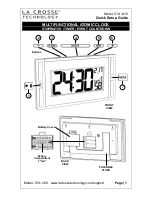
M
ULTI
-S
OURCE
S
YSTEM BASED ON
S
YSTEM
7001RC
Multi-Source Function System 7001RC - V02.01
21 / 31
hopf
Elektronik GmbH
Nottebohmstr. 41 • D-58511 Lüdenscheid • Tel.: +49 (0)2351 9386-86 • Fax: +49 (0)2351 9386-93 • Internet: http://www.hopf.com • E-Mail: [email protected]
2.4 Synchronisation Signal Requirements
The following signals can currently be used to synchronise a multi-source system:
•
GPS signal
– to receive with a
hopf
GPS antenna device
•
DCF77
pulse with:
DCF77 L pulse length: 100ms
DCF77 H pulse length: 200ms
DCF77 pulse can be low or high active
TTL level
•
Serial
hopf
Master/Slave-String
– with the following transmission levels:
TTL
RS422
Feeding other signal levels and time transfer formats
In order to make the connection of various signal sources available to the
user, additional components are available for
signal conversion
:
•
To convert
signal levels
such as e.g. RS232, TTY or LWL to
the level required by the internal system
•
To transform
time transfer formats
such as e.g. IRIG-B to
the formats required by the internal system
When planning a multi-source system any necessary signal adaptation
should be borne in mind at the outset.
hopf
Elektronik GmbH is always at your service to provide professional
consultancy services.
2.5 Sync. Source Requirements
The sync. sources must have the following characteristics:
•
Transmission of local time (synchronisation channels 2 and 3) or UTC time
(synchronisation channels 1 and 3)
•
Preservation of the synchronisation channel format
•
Continuous, strictly increasing time information
•
Plausibility of time information (e.g. no 31 February)
If the received time is recognised as plausible then this is accepted by the
system without any further verification.
This means that any information incorrectly transmitted by the source is
accepted as being correct. For this reason the user should verify the
correctness of the time information transmitted by the source.











































